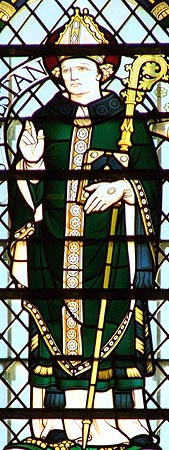
EBK Home
Kingdoms
Royalty
Saints
Pedigrees
Archaeology
King Arthur
Adversaries
Mail David
 St. Wulfstan II,
St. Wulfstan II,Bishop of Worcester
(Died 1008-1095)
This Wulfstan was the founder of the existing cathedral at Worcester and the great patron saint of the city. Wulfstan was born at Long Itchinton in Warwickshire. Both his father and mother had embraced monasticism in mature life and their son, after having been educated in the great monastery of Medeshamstead (Peterborough), became himself a monk at Worcester and, eventually, the prior of his convent.
Wulfstan, it is said, enjoyed his food and had a particular liking for roast goose. One day, he gave the order for such a bird to be prepared for dinner. He then went about his ordinary business. There were many clients of the Bishop to whom he had to pay attention and he was involved in many secular duties. He not yet taken breakfast when he was called upon to officiate at the Mass. In due time, he entered the church in a state of extreme hunger. He passed into the chancel, near to which, unfortunately, the kitchen was placed. A whiff of goose soon affected his olfactory nerves and the savour interfered with his devotions. His thoughts wandered to his dinner, but, fortunately, his conscience reproached him. His resolution was immediate. Then and there before the altar, he vowed that, from that time forth, he would never taste meat; and he remained a vegetarian for the rest his life - except on festivals when he ate fish.
On the translation of Aeldred to the see of York, in 1062, Wulfstan became Bishop of Worcester. Aeldred took with him twelve vills, appropriating them to York. The Archbishop had only a life-interest in the see, so these estates should have been restored at his decease. When he died, however, in 1069, they passed with his other estates into the hands of the King. Wulfstan was not disposed to give them up and planned to get them restored at the Council of Winchester, held at Easter 1070. As the Archbishopric of York was then vacant, however, the consideration of the question was deferred. When Thomas, the new Archbishop of York, went to Rome for the pall, he claimed the Bishop of Worcester as a suffragan. This question was left by the Pope to the determination of Archbishop Lanfranc of Canterbury. It was settled in a synod which was held in 1072. Bishop Odo of Bayeux was on Thomas' side, but Lanfranc decided against him. The twelve vills were to be given up and Worcester was, for the future, to be subordinated to Canterbury and not to York. In this judgment Archbishop Thomas seems to have quietly acquiesced.
Lanfranc looked with extreme doubt and jealousy on the Saxon clergy. At the Synod of Pedrede (Petherton in Somerset) in 1070, he charged Wulfstan with "insufficiency and want of learning," intending to remove him from his see, just as Aegelmar had been deposed from the East Anglian bishopric in the early part of the same year. Wulfstan's competency was, however, fully proved and it is possible that the whole charge against him may have arisen from his ignorance of Norman-French. A later legend asserted that, when Wulfstan was called upon to deliver up his pastoral staff, he refused to do so except to King Edward the Confessor, from whom he had received it. Accordingly, he laid the staff on the Confessor's shrine, which opened to receive it! No-one was able withdraw it from the tomb save for Wulfstan himself who was, of course, permitted to retain his see.
The simplicity, earnestness, and incessant labour of Wulfstan's pastoral life, says William of Malmesbury, are borne out by all the chroniclers. On his Episcopal manors, he built no halls or "dining chambers," giving his whole attention to more important matters and, even in the churches which he built, he disapproved of rich and elaborate ornamentation. The church and monastery of St. Oswald at Worcester proved too small for the increasing number of monks. So Wulfstan pulled them down and laid the foundations of the existing cathedral. He lived, apparently, to complete much of his work; but all that now remains of his cathedral is the crypt. Whilst witnessing the destruction of Oswald's church, Wulfstan burst into tears, declaring that he was pulling down the work of a far holier man than himself - a church in which so many saints had served God. Wulfstan died on 19th January 1095 and was buried beside the High Altar in his cathedral.
Edited from Richard John King's "Handbook to the Cathedrals of England:
Western Division" (1867).
